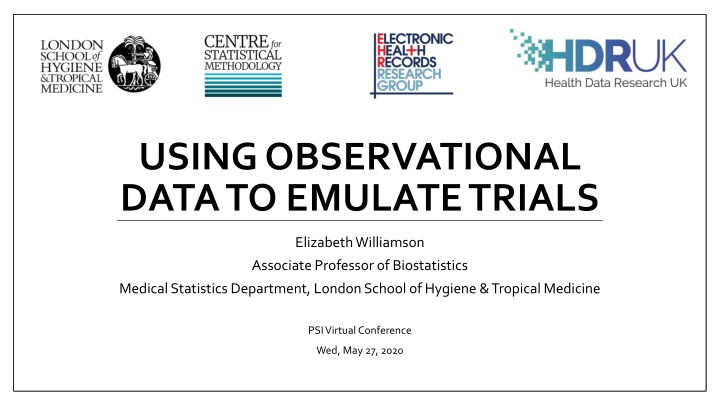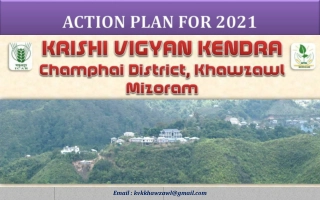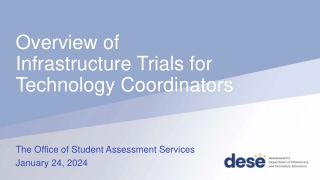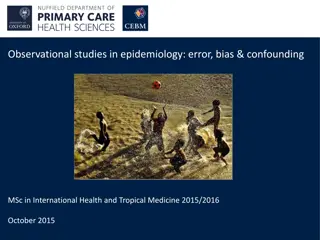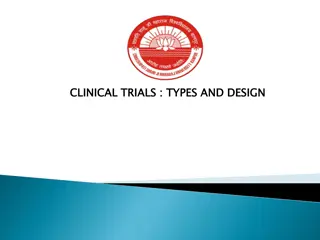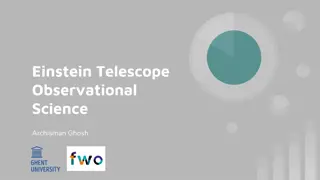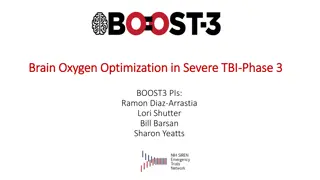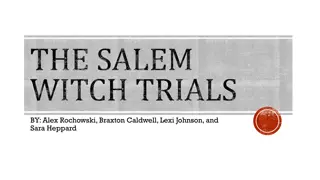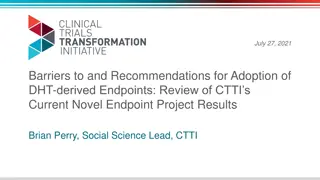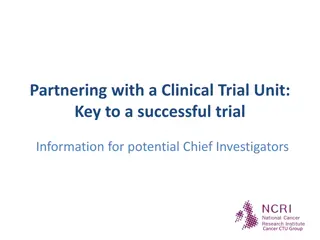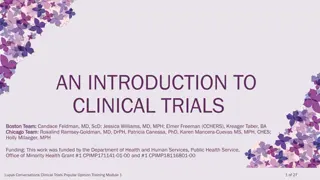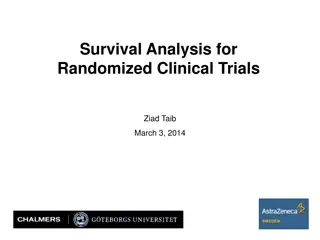Using Observational Data to Emulate Trials
Elizabeth Williamson, Associate Professor of Biostatistics, discusses the use of observational data to emulate trials, providing valuable insights for informing future randomized controlled trials (RCTs) and hypothesis generation. The examples presented demonstrate how routinely collected data can complement trial data, aiding in the estimation of treatment effects and generalizing results to wider populations. The presentation also touches on the importance of explicitly framing investigations as emulations of hypothetical randomized trials. This approach offers a novel perspective on leveraging real-world data in research settings.
Download Presentation

Please find below an Image/Link to download the presentation.
The content on the website is provided AS IS for your information and personal use only. It may not be sold, licensed, or shared on other websites without obtaining consent from the author.If you encounter any issues during the download, it is possible that the publisher has removed the file from their server.
You are allowed to download the files provided on this website for personal or commercial use, subject to the condition that they are used lawfully. All files are the property of their respective owners.
The content on the website is provided AS IS for your information and personal use only. It may not be sold, licensed, or shared on other websites without obtaining consent from the author.
E N D
Presentation Transcript
USING OBSERVATIONAL DATA TO EMULATE TRIALS Elizabeth Williamson Associate Professor of Biostatistics Medical Statistics Department, London School of Hygiene & Tropical Medicine PSI Virtual Conference Wed, May 27, 2020
Acknowledgements Example 1 The MACRO team Spiros Denaxas, UCL James Carpenter, LSHTM Example 2 Kevin Wing, James Carpenter, Liam Smeeth, Ian Douglas, Lesley Wise, LSHTM, UK Jennifer K Quint, Imperial College London, UK Sebastian Schneeweiss,Harvard Medical School, Division of Pharmacoepidemiology and Pharmacoeconomics, Department of Medicine, Brigham and Women's Hospital, Boston, Massachusetts, USA
Overview Routinely collected data contain a wealth of information, which can provide an important and useful complement to trial data Ways in which these data may be used include Inform the planning of future RCT E.g. safety of planned trial Hypothesis generation Estimation of parameters for power calculations Generalising RCTs Extending results to wider populations which were excluded from trials When using routinely collected data to address these questions, it can be helpful to explicitly phrase these investigations in terms of emulations of a hypothetical randomised trial (Garc a- Alb niz , EurJ Epi, 2017, Danaeiet al, SMMR, 2017). Today: present two examples of trial emulation, each undertaken for a different purpose
EXAMPLE 1: INFORMING A RCT To estimate the effect of macrolide antibiotic prescription on all cause and cardiovascular mortality
MACRO Defining best Management for Adults with Chronic RhinOsinusitis) NIHR-funded programme of work establish best practice for adults with chronic rhinosinusitis(CRS) The 7-year programme comprises workstreams to explore NHS care pathways undertake a randomised controlled trial to evaluate a longer-term course of macrolide antibiotics and endoscopic sinus surgery for patients with CRS Macrolides Macrolide antibiotics have been shown to have anti-inflammatory and immunomodulatory properties, reducing the pro-inflammatory cytokines critical in CRS (Head 2016, Oakley 2017) International guidelines recommend the use of low-dose, long-term macrolides in selected patients with CRS but the evidence is weak (Videler2011, Wallwork 2006) A survey of 158 UK ENT surgeons (2013) found that 92% prescribed antibiotics prior to ESS surgery, with 16% prescribing 12 weeks macrolide treatment (Sylvester, 2013) Reference: Blackshaw et al, Trials, 2019
Cardiovascular risks and macrolides However, concerns have been raised about potential cardiovascular risks from the use of full-dose, short-term macrolides (e.g. Winkel, 2016) Macrolides may cause prolongation of the QT interval which can lead to arrhythmia and myocardial infarction. However, previous studies primarily considered patient populations with high risk of cardiovascular events Study (safety) question: Is macrolide antibiotic prescription associated with an increased risk of all- cause and cardiac death, and cardiovascular outcomes, compared to penicillin prescription, in patients with chronic rhinosinusitis?
Hypothetical trial design Aim To estimate the effect of macrolide antibiotic prescription compared with penicillin prescription on risk of all-cause and cardiac death, and cardiovascular outcomes, in patients with chronic rhinosinusitis 16 to 80 years of age Diagnosis of CRS No recorded antibiotic prescription of any type in the last four weeks (a washout period) Provide informed consent to participate Antibiotic prescription (dose guidelines provided) of penicillin or a macrolide Eligibility Treatment strategy
Hypothetical trial design Assignment Randomly assign patients to either penicillin or a macrolide From baseline until death, loss to follow-up, 9 years after baseline, or end of study (administrative censoring end 2016). Sensitivity: censor at 30 days. Primary: all-cause mortality, Secondary: cardiovascular mortality, myocardial infarction Intention-to-treat (compare groups irrespective of subsequent antibiotics taken) Compare risks in group assigned macrolide to group assigned penicillin (unadjusted model) Follow-up Outcome Estimand Analysis
Trial emulation Aim to emulate the desired (hypothetical) trial using electronic health record data Setting: Clinical Practice Research Datalink (CPRD) linked with Office for National Statistics (ONS) mortality data, and Hospital Episodes Statistics (HES) Population: Adult patients with chronic rhinosinusitis, 1997-2016 prescribed 1+ macrolide or penicillin
Trial emulation Hypothetical trial To estimate the effect of macrolide antibiotic prescription compared with penicillin prescription on risk of all-cause and cardiac death, and cardiovascular outcomes, in patients with chronic rhinosinusitis 16 to 80 years of age Diagnosis of CRS No recorded antibiotic prescription of any type in the last four weeks (a washout period) Provide informed consent to participate Antibiotic prescription (dose guidelines provided) of penicillin or a macrolide Emulated trial Same Aim Same, except consent not sought Eligibility Same, except dose at discretion of clinician Treatment strategy
Trial emulation Hypothetical trial Randomly assign patients to either penicillin or a macrolide Emulated trial Patients non-randomly offered prescription, based on: demographics, prior prescription history, prior diagnoses and calendar time. Same Assignment Follow-up From baseline until death, loss to follow-up, 9 years after baseline, or end of study (administrative censoring end 2016). Sensitivity: censor at 30 days. Primary: all-cause mortality, Secondary: cardiovascular mortality, myocardial infarction Intention-to-treat (compare groups irrespective of subsequent antibiotics taken) Compare risks in group assigned macrolide to group assigned penicillin (unadjusted model) Outcome Same Estimand Same Analysis Same comparison, adjusted for variables above
Study overview: confounders Demographics Age, sex, BMI, smoking status, alcohol consumption, region, socio-economic status, frequency of GP consultations in last year Prior prescription of: antidepressants, warfarin or digoxin, anti-arrhythmic drugs, anticoagulants, antiplatelet drugs, -adrenoceptor blockers, lipid regulating drugs, diuretics, nitrates, non-steroidal anti-inflammatories (NSAIDs) and anti-hypertensive drugs including angiotensin- converting enzyme inhibitors. Prior diagnosis of: atrial fibrillation, cancer, COPD, diabetes, dyslipidaemia, hypertension, cardiovascular disease, and asthma, were also identified (CALIBER) Updated over time Reference: Denaxas et al, Int J Epi, 2012
Emulated trial design Series of observational pseudo trials Study period split into non-overlapping 30-day periods (219 time intervals). Each interval considered a recruitment period for a pseudo-trial. At each prescription, a patient was assessed for eligibility. If eligible at that point, the patient entered that pseudo-trial (in the arm corresponding to prescription). Patients could enter each pseudo-trial only once, but could enter multiple pseudo-trials over the whole study period. Analysis Cox proportional hazards regression Timescale: time since entering pseudo trial Age at entry and pseudo-trial modelled using splines Robust standard errors (can enter multiple pseudo-trials) Reference: Denaxas et al, Int J Epi, 2012
Results 66,331 unique patients, 23,465 of whom joined a pseudo trial in the macrolide group 57,876 of whom joined a pseudo trial in the penicillin group (thus 15,010 did both) Total of 320,798 prescriptions were included in the final analysis. Balance of patient characteristics Females, patients with prior use of antidepressants, a history of chronic obstructive pulmonary disease or asthma were more likely to receive a macrolide antibiotic Differences were fairly small. Median follow-up years (25th to 75th percentile: 2.0 to 7.4 years). Patients participated in median of 3 pseudo-trials (25th to 75th percentile: 2 to 6).
HR (95% CI) P All cause mortality Unadjusted Full follow-up 1.04 (0.95, 1.13) 0.99 (0.91, 1.09) 0.446 0.865 Censored 30 days 0.93 (0.70, 1.24) 0.628 CVD mortality Unadjusted 1.01 (0.83, 1.23) 0.890 Full follow-up 1.00 (0.82, 1.21) 0.961 Censored 30 days 0.99 (0.56, 1.77) 0.983 MI Unadjusted 1.10 (0.94, 1.29) 0.252 Full follow-up 1.09 (0.93, 1.28) 0.300 Censored 30 days 1.60 (0.95, 2.68) 0.077
Conclusions The trial emulation showed little evidence of long term risks in this population, but a short term MI risk Modifications made to planned trial: Additional exclusions from MACRO trial: prior history of ischaemic heart disease and aged over 65 years with diabetes prolongation of QT interval (baseline electrocardiogram added to the trial screening process)
EXAMPLE 2: GENERALISING RCTS To estimate Real World Effects of medications for Chronic Obstructive Pulmonary Disease
Chronic Obstructive Pulmonary Disease (COPD) exacerbations Acute COPD exacerbations often result in hospitalisation 3 commonly used types: Long-acting beta-agonists (LABA) Inhaled corticosteroids (ICS) Long-acting muscarinic antagonists (LAMAs) Long term pharmacological treatment generally required Seretide (widely used) Salmeterol (an ICS) & fluticasone propionate (a LABA) Evidence for use: GSK sTORCH trial (2007):
Motivation A large number of patients with COPD in the general population would have been excluded from or were underrepresented in the TORCH trial In particular, patients with milder COPD were not included Aim To emulate the TORCH trial using electronic health record data (CPRD linked to HES) to identify major sources of bias (confounding by indication) To then use the same trial emulation methods (without the TORCH aspect) to specific patient groups who would have been excluded from the TORCH trial
TORCH RCT results for rate of exacerbations N=6112 (approx n=1500 per group) Comparison Seretide* vs placebo Seretide vs salmeterol Seretide vs fluticasone propionate Rate Ratio (95% CI) 0.75 (0.69-0.81) 0.88 (0.81-0.95) 0.91 (0.84-0.99) *Seretide=salmeterol (an ICS) & fluticasone propionate (a LABA) in combination
TORCH trial design Aim To estimate the effect of a combination regimen (salmeterol at a dose of 50 g plus fluticasone propionate at a dose of 500 g twice daily) compared to placebo, salmeterol alone, or fluticasone propionate alone on 3-year risk of death and rate of exacerbations. Inclusion criteria current or former smokers (>10-pack-year) 40 to 80 years diagnosis of COPD, pre-bronchodilator FEV1 < 60% predicted value; FEV1 : FVC <= 0.70 FEV1 increase <10% predicted with 400 g of albuterol Written informed consent Eligibility
TORCH trial design Eligibility Exclusion, many, including Asthma diagnosis within the previous 5 years Other lung conditions Other COPD therapies (long-acting bronchodilator, oral corticosteroids) History of substance abuse Oxygen therapy Chance of death or interference with study Current therapy with an oral corticosteroid Record for an exacerbation during the trial run-in period
TORCH trial design Treatment strategy Salmeterol at a dose of 50 g plus fluticasone propionate at a dose of 500 g twice daily Randomly assign patients to either combination, salmeterol alone, fluticasone propionate, or placebo From baseline until death, loss to follow-up, 3 years after baseline. Primary: all-cause mortality, Secondary: exacerbations Intention-to-treat (compare groups irrespective of subsequent treatment) Compare risks and rates between randomised groups Assignment Follow-up Outcome Estimand Analysis
Emulation of TORCH trial design TORCH trial Emulated trial Aim To estimate the effect of a combination regimen (salmeterol at a dose of 50 g plus fluticasone propionate at a dose of 500 g twice daily) compared to placebo, salmeterol alone, or fluticasone propionate alone on 3-year risk of death and rate of exacerbations. Eligibility Inclusion criteria current or former smokers (>10-pack-year) 40 to 80 years diagnosis of COPD pre-bronchodilator FEV1 < 60% predicted value FEV1 : FVC <= 0.70 FEV1 increase <10% predicted with 400 g of albuterol Written informed consent To estimate the effect of a combination regimen compared to placebo, salmeterol alone, or fluticasone propionate alone on rate of exacerbations. Inclusion criteria smokers 40 to 80 years diagnosis of COPD FEV1 , FVC measured FEV1 < 60% predicted value FEV1 : FVC <= 0.70
Emulation of TORCH trial design TORCH trial Emulated trial Some (not listed) not imposed, e.g. -1 antitrypsin deficiency Eligibility Exclusion, many, including Asthma diagnosis within the previous 5 years Other lung conditions Other COPD therapies (long-acting bronchodilator, oral corticosteroids) History of substance abuse Oxygen therapy Chance of death or interference with study Current therapy with an oral corticosteroid Record for an exacerbation during the trial run-in period Some defined differently
Emulation of TORCH trial design TORCH trial Emulated trial Treatment strategy Salmeterol at a dose of 50 g plus fluticasone propionate at a dose of 500 g twice daily, separate therapy, or placebo Randomly assign patients to either combination, salmeterol alone, fluticasone propionate, or placebo From baseline until death, loss to follow- up, 3 years after baseline. Primary: all-cause mortality, Secondary: exacerbations Intention-to-treat (compare groups irrespective of subsequent treatment) Compare risks and rates between randomised groups Salmeterol plus fluticasone propionate Separate therapy Neither Patients prescribed treatments according to demographics, prior medications and diagnoses. Same Assignment Follow-up Exacerbations only (nb: only known if treatment sought) Same Outcome Estimand Adjusted analysis Analysis
Effect modification We want to emulate a RCT but with an additional step of matching the baseline characteristics to the trial population included in TORCH, to guard against differences resulting from heterogeneity in treatment effects Steps: Seretide vs nothing (placebo) For each TORCH participant, identify a comparable CPRD patient Not receiving Seretide (or salmeterol or fluticasone propionate) eligible for trial comparable 1:1 matched on characteristics likely to affect treatment effect Age, sex, BMI Exacerbation history Cardiovascular disease Lung function 1. For each selected CPRD patient, select a comparable Seretide-exposed CPRD patient Receiving Seretide eligible for trial comparable Propensity-Score Matched on all confounders 2.
1 person 1. 1st date of study eligibility (person meets all TORCH criteria) 2. Eligible to enter study as an untreated participant 3. Eligible to enter study as a treated participant 4. Eligible to enter study as an untreated participant 5. Eligible to enter study as a treated participant 1 week No FP/Sal FP/Sal
Results eligible entry points N=73,889 patients in HES-linked CPRD with a COPD diagnosis 2004-2016 n=61,899 after applying TORCH age restrictions (age 40-80 yrs) n=56,169 after removing non-smokers n=37,055 of whom have lung function measured (FEV1, FEV1/FVC2) n=18,715 after removing those with FEV1 60%, FEV1/FVC>0.7 n=18,715 Unexposed (to Seretide) Exposed (to Seretide) 20,829 records (from n=11,285 people) 11,593 records (from n=4,788 people)
Results matching CPRD to TORCH data 1:1 matched on: - Age - Sex - BMI - Exacerbation history - Cardiovascular disease - Lung function n=20,829 unexposed records n=6,112 people from the TORCH COPD trial n=900 people from TORCH not matchable n=5,212 TORCH-matched unexposed people
Results matching unexposed records to TORCH participants
Results analysis of exacerbations Comparison Rate Ratio (95% CI) TORCH Seretide* vs placebo 0.75 (0.69-0.81) CPRD Seretide vs no seretide Crude 1.44 (1.36-1.53) Matched on propensity score 1.25 (1.14-1.37) Strong confounding by indication Patients in CPRD not receiving treatment had fewer exacerbations (i.e. were less sick)
Results analysis of exacerbations Comparison Rate Ratio (95% CI) TORCH Seretide* vs salmeterol 0.88 (0.81-0.95) CPRD Seretide vs no salmeterol Crude 0.80 (0.72-0.88) Matched on propensity score 0.84 (0.73-0.97)
Trial emulation Real world data complementary to RCTs Trial emulation can be a useful framework in which to embed causal questions using real world data Useful statistical considerations Allowing patients to repeatedly participate in pseudo-trials increases power Can map the distribution of baseline characteristics in the emulated trial to match a real trial, to guard against treatment effect heterogeneity
References emulating trials Danaei et al. Observational data for comparative effectiveness research: an emulation of randomised trials to estimate the effect of statins on primary prevention of coronary heart disease. SMMR, 2013, 22(1):70-96. Garc a-Alb niz X, Hsu J, Hern n MA.The value of explicitly emulating a target trial when using real world evidence: an application to colorectal cancer screening. European Journal of Epidemiology, 2017, 32(6):495-500
References macrolides Blackshaw H, Vennik J, Philpott C, et al. Expert panel process to optimise the design of a randomised controlled trial in chronic rhinosinusitis (the MACRO programme) Trials, 2019; 20: 230. Winkel P, Hilden J, Hansen JF, Kastrup J, Kolmos HJ, Kjoller E, Jensen GB, Skoog M, Lindschou. J, Gluud C et al: Clarithromycin for stable coronary heart disease increases all-cause and cardiovascular mortality and cerebrovascular morbidity over 10 years in the CLARICOR randomised, blinded clinical trial. Int J Cardiol 2015, 182:459-465 Oakley GM, Harvey RJ, Lund VJ. The role of macrolides in chronic rhinosinusitis (CRSsNP and CRSwNP). Curr Allergy Asthma Rep. 2017;17(5):30. Head K, Chong LY, Piromchai P, Hopkins C, Philpott C, Schilder AG, Burton MJ. Systemic and topical antibiotics for chronic rhinosinusitis. Cochrane Database Syst Rev. 2016;4:CD011994. Videler WJ, Badia L, Harvey RJ, Gane S, Georgalas C, van der Meulen FW, Menger DJ, Lehtonen MT, Toppila-Salmi SK, Vento SI, et al. Lack of efficacy of long-term, low-dose azithromycin in chronic rhinosinusitis: a randomized controlled trial. Allergy. 2011;66(11):1457 1468. Wallwork B, Coman W, Mackay-Sim A, Greiff L, Cervin A. A double-blind, randomized, placebo-controlled trial of macrolide in the treatment of chronic rhinosinusitis. Laryngoscope. 2006;116(2):189 193. Sylvester DC, Carr S, Nix P. Maximal medical therapy for chronic rhinosinusitis: a survey of otolaryngology consultants in the United Kingdom. Int Forum Allergy Rhinol. 2013;3(2):129 132 Denaxas SC, George J, Herrett E, Shah AD, Kalra D, Hingorani AD, Kivimaki M, Timmis AD, Smeeth L, Hemingway H: Data Resource Profile: Cardiovascular disease research using linked bespoke studies and electronic health records (CALIBER). Int J Epidemiol 2012, 41(6):1625-1638.
References COPD http://www.soundcare.ca/pm_copd.htm (COPD patient image) https://www.who.int/news-room/fact-sheets/detail/the-top-10-causes-of-death Healthcare Commission (2006) Clearing the air: a national study of chronic obstructive pulmonary disease. London: Healthcare Commission Calverley, P. M., Anderson, J. A., Celli, B. R., Ferguson, G. T., Jenkins, C., Jones, P. W., Vestbo, J. (2007). Salmeterol and Fluticasone Propionate and Survival in Chronic Obstructive Pulmonary Disease. New England Journal of Medicine, 356(8), 775 789. Tashkin, D. P., Celli, B., Senn, S., Burkhart, D., Kesten, S., Menjoge, S., & Decramer, M. (2008). A 4- Year Trial of Tiotropium in Chronic Obstructive Pulmonary Disease. New England Journal of Medicine, 359(15), 1543 1554. Wing, K; Williamson, E; Carpenter, JR; Wise, L; Schneeweiss, S; Smeeth, L; Quint, JK; Douglas, I; (2018) Real-world effects of medications for chronic obstructive pulmonary disease: protocol for a UK population-based non-interventional cohort study with validation against randomised trial results. BMJ open, 8 (3). e019475. ISSN 2044-6055 DOI: https://doi.org/10.1136/bmjopen-2017- 019475
